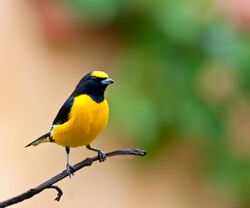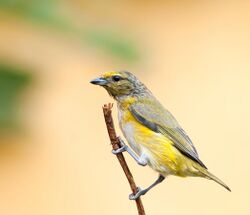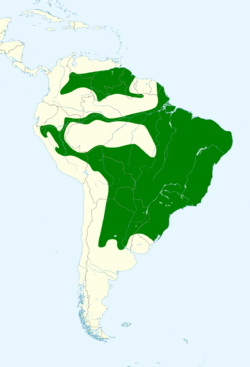Biology:Purple-throated euphonia
| Purple-throated euphonia | |
|---|---|

| |
| Male in Brazil | |

| |
| Female in Brazil | |
| Scientific classification | |
| Domain: | Eukaryota |
| Kingdom: | Animalia |
| Phylum: | Chordata |
| Class: | Aves |
| Order: | Passeriformes |
| Family: | Fringillidae |
| Subfamily: | Euphoniinae |
| Genus: | Euphonia |
| Species: | E. chlorotica
|
| Binomial name | |
| Euphonia chlorotica (Linnaeus, 1766)
| |

| |
| Synonyms | |
|
Tanagra chlorotica Linnaeus, 1766 | |
The purple-throated euphonia (Euphonia chlorotica) is a songbird species in the family Fringillidae. It was formerly placed in the Thraupidae.
It is found in Argentina , Bolivia, Brazil , Colombia, Ecuador, French Guiana, Guyana, Paraguay, Peru, Suriname, Uruguay, and Venezuela.
Its natural habitats are subtropical or tropical moist lowland forests and heavily degraded former forest.
In 1760 the French zoologist Mathurin Jacques Brisson included a description of the purple-throated euphonia in his Ornithologie based on a specimen collected in Cayenne, French Guiana. He used the French name Le tangara noir et jaune de Cayenne and the Latin Tangara Cayanensis Nigrolutea.[2] Although Brisson coined Latin names, these do not conform to the binomial system and are not recognised by the International Commission on Zoological Nomenclature.[3] When in 1766 the Swedish naturalist Carl Linnaeus updated his Systema Naturae for the twelfth edition, he added 240 species that had been previously described by Brisson.[3] One of these was the purple-throated euphonia. Linnaeus included a brief description, coined the binomial name Tanagra chlorotica and cited Brisson's work.[4] The specific name chlorotica is from the Ancient Greek khlōrotēs "greenness".[5] This species is now placed in the genus Euphonia that was introduced by the French zoologist Anselme Gaëtan Desmarest in 1806.[6] There are five subspecies.[7]
References
- ↑ BirdLife International (2018). "Euphonia chlorotica". IUCN Red List of Threatened Species 2018: e.T22722706A132017181. doi:10.2305/IUCN.UK.2018-2.RLTS.T22722706A132017181.en. https://www.iucnredlist.org/species/22722706/132017181. Retrieved 12 November 2021.
- ↑ Brisson, Mathurin Jacques (1760) (in French, Latin). Ornithologie, ou, Méthode contenant la division des oiseaux en ordres, sections, genres, especes & leurs variétés. 3. Paris: Jean-Baptiste Bauche. pp. 34–35, Plate 2 fig 3. https://biodiversitylibrary.org/page/35952983. The two stars (**) at the start of the section indicates that Brisson based his description on the examination of a specimen.
- ↑ 3.0 3.1 Allen, J.A. (1910). "Collation of Brisson's genera of birds with those of Linnaeus". Bulletin of the American Museum of Natural History 28: 317–335.
- ↑ Linnaeus, Carl (1766) (in Latin). Systema naturae : per regna tria natura, secundum classes, ordines, genera, species, cum characteribus, differentiis, synonymis, locis. 1, Part 1 (12th ed.). Holmiae (Stockholm): Laurentii Salvii. p. 317. https://biodiversitylibrary.org/page/42946513.
- ↑ Jobling, J.A. (2018). "Key to Scientific Names in Ornithology". in del Hoyo, J.; Elliott, A.; Sargatal, J. et al.. Handbook of the Birds of the World Alive. Lynx Edicions. https://www.hbw.com/dictionary/definition/chlorotica-chloroticus.
- ↑ Desmarest, Anselme Gaëtan (1806) (in French). Histoire naturelle des tangaras, des manakins et des todiers. Paris: Garnery. p. 35 and plate 27 (pages and plates are not numbered). https://www.biodiversitylibrary.org/page/40241826.
- ↑ Gill, Frank; Donsker, David, eds (2018). "Finches, euphonias, longspurs, Thrush-tanager". World Bird List Version 8.1. International Ornithologists' Union. http://www.worldbirdnames.org/bow/finches/.
Wikidata ☰ Q268032 entry
 |


